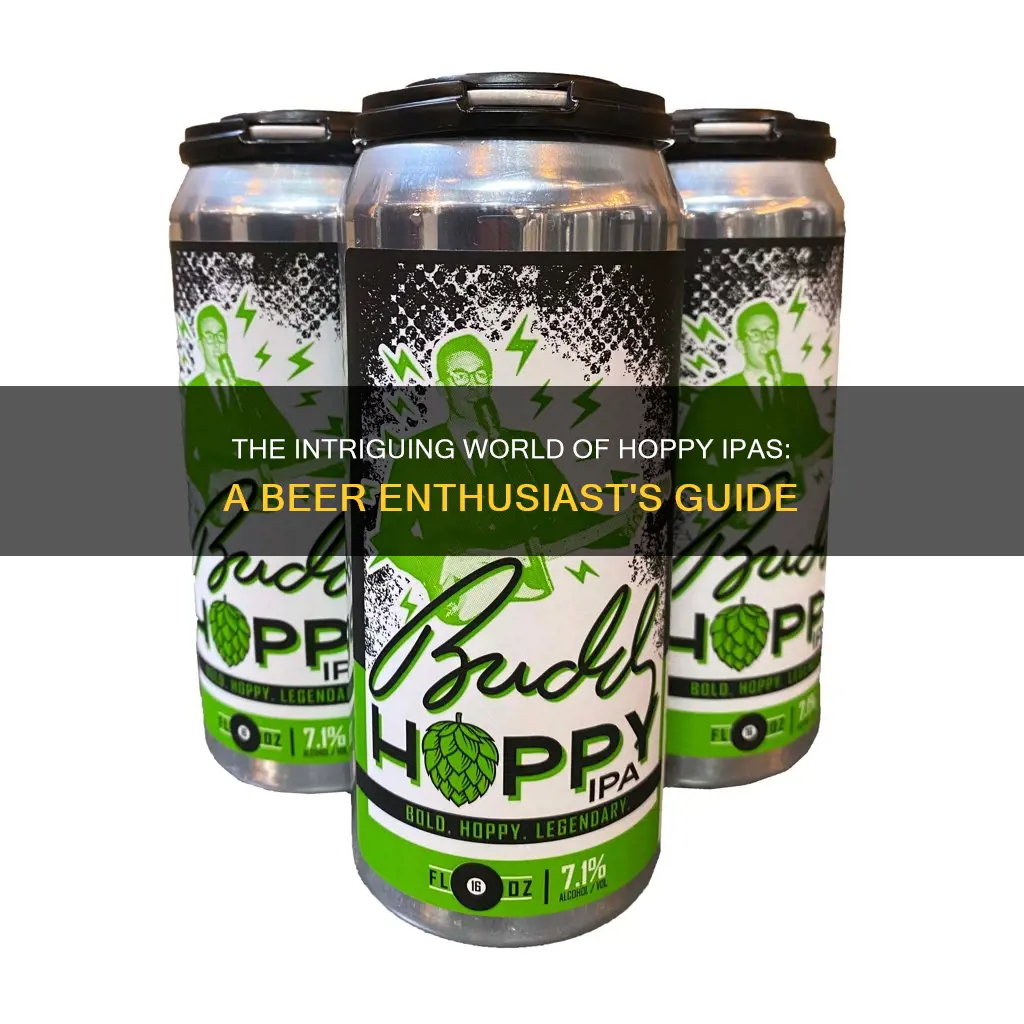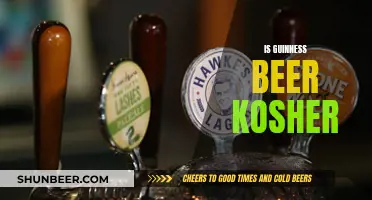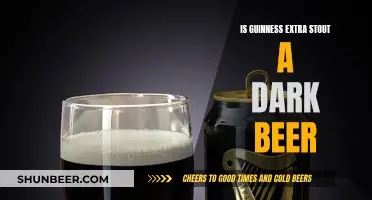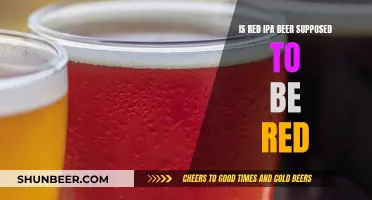
India Pale Ale (IPA) is a hoppy beer style within the broader category of pale ale. The hop plant is believed to have originated in Ancient Egypt and was used as a salad plant. It is thought to have first been used to flavour a fermented beverage in medieval Germany, from where its cultivation spread across Europe. Hops can be added to beer during or after fermentation. Their primary purpose is to add bitterness to the brew, but they can also add a range of other flavour characteristics. While the term hoppy is often used as shorthand for bitter, today's brewers are using new techniques to focus on other flavours, such as notes of berries, melon, grapefruit, and white wine grapes.
Characteristics of Hoppy IPA Beer
| Characteristics | Values |
|---|---|
| Flavour | Bitter, fruity, floral, earthy, piney, citric, spicy, herbal, resinous, sweet |
| Aroma | Fruity, floral, spicy, earthy, piney, citrus |
| Alcohol Content | 5.5% to 7.5% |
| Bitterness | Measured on the International Bitterness Units (IBUs) scale |
What You'll Learn

What is an IPA?
IPA stands for Indian Pale Ale or India Pale Ale. The drink gets its name from its historical origins: British sailors on their long voyages to India in the 18th century. The beer was brewed with lots of hops to survive the long journeys without going bad.
IPAs are known for their characteristic hoppy flavour. You can expect a hops-forward taste with plenty of citrus and fruit notes. They also tend to have a higher ABV than most other types of beer, typically ranging from 6-7% ABV, although some can go as high as 10%.
There are several different types of IPAs, including:
- West Coast IPA: This is a traditional IPA that is hoppy, fruity, and crisp, with some bitter varieties.
- New England/East Coast IPA: This style of IPA is very hazy and has an intense fruit flavour as well as hops. They are often fermented to have lower carbonation.
- Session IPA: These are designed for casual drinking sessions and have a lower alcohol content, typically around 4-5% ABV. They are less hoppy and have a more subtle flavour than other IPAs.
- British IPA: These are less common in the United States as they don't have the same flavour complexity as other IPAs. They tend to be very hoppy and one-note.
- Double/Imperial IPA: These have more malts and hops to balance out the sweetness, resulting in a higher alcohol content.
- Triple IPA: Even stronger than a Double IPA, with more hops and a higher ABV of up to 18%.
The modern approach to IPAs explores the world of fruity flavours that can be derived from hops, rather than focusing solely on bitterness.
Guinness Book and Beer: Any Connection?
You may want to see also

What does a hoppy beer taste like?
Hops are one of the four basic ingredients of beer, along with malt, yeast, and water. Hops are added to beer during or after fermentation, primarily to add bitterness to the brew, but they can also add a range of other flavour characteristics. The hoppy taste of a beer is determined by the type of hop, the amount used, and how it is used.
The phrase "hoppy beer" can refer to a beer's smell, its flavour profile, as well as the literal volume of hops in its recipe. When we talk about hoppiness, it is a mistake to think only of bitterness. Beers that are most likely to be described as "hoppy" are the ones with the most bitter flavour or the ones that have fruity, floral, piney, earthy, or citrusy aromas.
The hop plant is believed to have originated in Ancient Egypt and was used as a salad plant. It is thought to have first been used to flavour a fermented beverage in medieval Germany, from where its cultivation spread across Europe.
Different varieties of hops are preferred by brewers for different purposes. For example, Chinook adds a medium bitterness and gives notes of grapefruit, pine resin, and sometimes a little spice. Galena is a medium-bitterness hop that adds elements of citrus and gives a pleasant, mellow bitterness to the finished beer. Centennial is a flowery hop that adds perfume and a medium hoppy bitterness, with notes of pine and florals.
While the term "hoppy" is often associated with bitterness, it is important to note that hops can also contribute to the aroma and flavour of a beer without adding bitterness. This is achieved by adding the hops later in the brewing process, during the beer's final fermentation, in a process called "dry-hopping". This helps to preserve the aromatic oils in the hops. Examples of aroma hops include Cascade, Czech Saaz, and Fuggles.
In summary, a hoppy beer showcases the hop flavour, aroma, and bitterness that the hops contribute to the beer. The specific characteristics of a hoppy beer will depend on the type of hops used, the amount added, and the stage of the brewing process at which they are introduced.
Guinness vs Beer: What Sets Them Apart?
You may want to see also

How is a hoppy beer made?
A hoppy beer is made by adding hops to the wort when it enters the boiling stage of the brewing process. The high temperatures that the plant is exposed to cause the release of isohumulone, which adds a bitter flavour to the hot wort. Hops can also be added during or after fermentation, and they can be added at different stages of the boil to achieve different results.
The hop plant is believed to have originated in Ancient Egypt and was first used to flavour a fermented beverage in medieval Germany. Ale, an un-hopped beer, declined in popularity as the use of hops grew more widespread. Hops add bitterness to the brew, but they can also add a range of other flavour characteristics, such as fruitiness, piney notes, and floral notes.
The phrase "hoppy beer" can refer to a beer's smell, its flavour profile, or the literal volume of hops in its recipe. When we talk about hoppiness, it is a mistake to think only of bitterness. A hoppy beer showcases the hop flavour and aroma of the hops.
The beers that are most likely to be described as "hoppy" are the ones with the most bitter flavour or the ones that have fruity, floral aromas. Dark beers, like porters and stouts, are dominated by the taste of the malt component, so they would never be described as "hoppy". However, a West Coast IPA, for example, is likely to have a very high level of bitterness coupled with citrus flavours.
White IPA Beer: A Unique Hybrid Style
You may want to see also

What are the different types of IPAs?
The popularity of IPAs has led to an increase in variety, with each type of IPA having its distinct flavour profile and ABV. Here is a list of some of the different types of IPAs:
English/British IPA
The English IPA is the original IPA, with a more subtle aroma and an earthier flavour with lighter notes of citrus. The taste is closer to English pale ale, so you can expect the maltiness that is synonymous with English ales. British IPAs tend to be very hoppy and one-note.
West Coast IPA
The first West Coast IPAs were crafted in California. Their flavour is closer to an English IPA because they use crystal malt, making them less dry than many other IPAs. A traditional west coast IPA is hoppy, fruity, and crisp, with some bitter varieties.
East Coast IPA
East Coast IPAs use varieties of mutated British yeasts in addition to other fresh ingredients. These produce the intense hoppy and fruity flavours commonly associated with American IPAs. It is the stepping stone between the British and West Coast IPA, with an emphasis on piney hop flavour and a solid malt backbone.
New England/Hazy IPA
The New England IPA is what people are drinking now. This IPA is unfiltered, which makes it hazy, and has extremely low bitterness from using blends of hops that lend an intense, fruity flavour. New England IPAs are often dry-hopped and tend to be fermented to have lower carbonation.
Session IPA
Session IPAs are designed for casual drinking sessions, with a more sensible ABV of around 4-5%. They are the most subtle-flavoured of American IPAs and can be likened to English Pale Ales.
Double/Imperial IPA
Double and Imperial IPAs have a higher hop concentration. To balance the hop flavour, the brewer uses more malt, which results in a higher ABV (usually over 7%).
Triple IPA
Triple IPAs have even more hops than Double IPAs, making them dryer and more bitter. They also have very high ABV, reaching levels of up to 18% ABV, making them popular among seasoned beer drinkers.
Belgian IPA
The driving flavour in a Belgian IPA comes from Belgian yeast, which provides sweet, bready, warm notes to the beer. These usually taste like a British IPA mixed with a Belgian tripel.
Lactose/Milkshake IPA
Lactose IPAs get the nickname “Milkshake” because of the sweetness the milk sugar adds to the beer. It is common to see fruit or vanilla added to these IPAs to take the effect even further. With low carbonation, these usually end up drinking like a fruity milkshake.
Guinness Beer ABV: The Strongest Brews Revealed
You may want to see also

What are the common misconceptions about hoppy beers?
Hoppy beers, or IPAs, are a broad category of beers with a wide range of flavours and styles. However, there are several misconceptions about them:
All IPAs are bitter
IPAs are often associated with bitterness, but this is not always the case. While traditional British IPAs tend to be bitter, modern IPAs, especially those from the West Coast and New England, emphasise fruity notes. These IPAs are known for their tropical fruit, citrus, and floral flavours, with reduced bitterness.
Hoppy beers are always bitter
While hops can contribute to bitterness, "hoppy" does not necessarily equate to bitter. Today, "hoppy" can refer to a range of flavours, including berries, melon, grapefruit, and white wine grapes. Brewers are experimenting with new techniques to reduce bitterness and highlight the diverse flavours that hops can impart.
All IPAs have high alcohol content
While some IPAs, such as Double or Imperial IPAs, have higher alcohol content due to increased malt usage, not all IPAs will get you drunk quickly. Session IPAs, for example, typically have lower alcohol content, making them perfect for enjoying multiple drinks without excessive intoxication.
IPAs are only for hop lovers
The perception that IPAs are exclusively for hop enthusiasts is misleading. The diverse world of IPAs offers something for everyone. For those who find traditional IPAs too bitter, the emerging styles like New England IPAs or fruity IPAs provide a more balanced and approachable option. The key is to explore the various styles and find the one that suits your palate.
All IPAs taste the same
The assumption that all IPAs taste alike is far from the truth. IPAs exhibit an incredible range of flavours, from dank and tropical to piney and bitter. Brewers are constantly innovating, resulting in a dynamic and evolving landscape of IPA styles. Each IPA is unique, with its own combination of hops, malts, and brewing techniques, leading to distinct flavour profiles.
American IPA Beer: What's the Deal?
You may want to see also
Frequently asked questions
India Pale Ale (IPA) is a hoppy beer style within the broader category of pale ale. The hop plant is believed to have originated in Ancient Egypt and was first used to flavour a fermented beverage in medieval Germany. Hops add bitterness to the brew but can also add a range of other flavour characteristics.
A hoppy beer showcases the hop flavour and aroma of the hops. Hops can add a range of flavours to the beer, from fruity to piney to earthy to floral.
All beers contain hops, but a hoppy beer showcases the hop flavour and aroma, whereas a bitter beer will have a stronger bitter taste.
IPAs tend to have a higher ABV and IBU than other beers, meaning they have a higher alcohol content and are more bitter.
Some examples of hoppy IPA beers include:
- Bell's Two Hearted Ale
- Fuller's India Pale Ale
- Dogfish Head 120 Minute IPA







